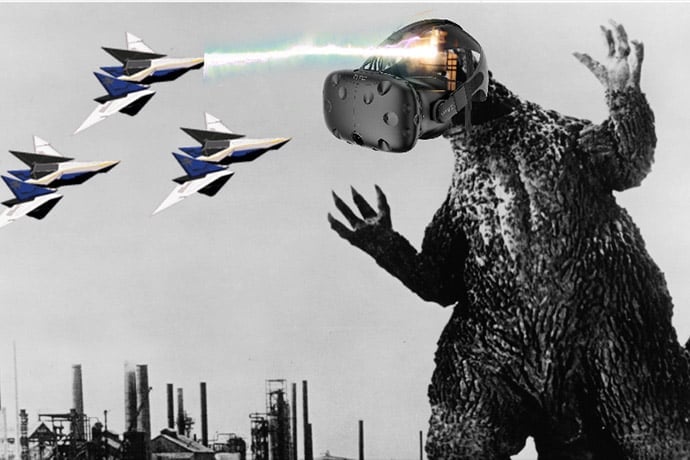Imagine if you could work with virtual reality hardware and software for class, with access to the software programmers and teams who created your tools. What would you build? Computer science students at the University of Washington in Seattle got this unusual chance earlier this year.
For 10 weeks, they created software apps using VR hardware and software with access to the teams who created the tools. There was a lot of back and forth about what the tools could do, as well as ideas how to improve them. The teams that built the hardware and software got the opportunity to see their work used the real world.
While we can’t be part of this unusual class, the professors and students posted a lot of their work online. Here are some of the apps they created. And the online article has links you can follow.
Keyboard
Use an actual virtual piano to learn how to play the piano. This app shows you what piano keys to press as you learn. More patient than a real life piano teacher, this app lets you learn at your own pace, repeating lessons until you memorize the lessons.
HOLOCOOKING
Instead of looking at your phone or other computer to read instructions, this app creates a platform that makes it possible to create tutorials and content to teach skills. You are shown the steps for the recipe with descriptions and ingredient lists for each step.

DawgFights
This augmented reality game can be played by one or two people. You fly a paper airplane around the room to navigate waypoints.

Titan Fightin’
This game lets you be the monster and fight your friends. Or work with your friends to take down the monster. Created for the HTC Vive headset and controllers, this game is an asymmetric multiplayer game. One player uses the Vive equipment to be the monster while other players use a VR headset and work together to fly jets to try and take down the monster.
According to Geekwire, the two professors who taught the course, Ira Kemelmacher-Shlizerman and Steve Seitz, acted as venture capitalists instead of teachers telling the students what to create. Students came up with ideas then worked with their professors to refine their ideas to what could be built in 10 weeks.
Students got the hands on opportunity to experience the current technical limits of virtual reality and augmented reality software tools and hardware. During the ten weeks, there was lots of failure and trial and error to create software that worked using Unity and other development tools.
The class also featured a weekly speaker from computer scientists and technologists building this new technology, including Michael Abrash, Chief Scientist at Oculus, Google artists Drew Stillman and Patrick Hackett who created the VR app Tilt Brush, and Neal Stephenson, futurist and author of Snow Crash. Many of the lectures are online at YouTube, with links in the online article.
If this sort of class interests you, it’s a wonderful reason to work to get into their school and schools like the University of Washington.
Learn More
Inside the ‘world’s first HoloLens class’: UW computer science students show mixed reality projects
Students demonstrate their HoloLens apps after a quarter of VR and AR design
CSE 481 Virtual and Augmented Reality Capstone
https://courses.cs.washington.edu/courses/cse481v/16sp/home.php
https://courses.cs.washington.edu/courses/cse481v/16sp/deliverables.php
https://www.youtube.com/channel/UCiOqneQsJNDW4RZGuY4cP-A
https://www.youtube.com/playlist?list=PLSCK7y_AEdoZLOjca-f0yNCtGl1MakBWt
https://www.youtube.com/playlist?list=PLSCK7y_AEdoZG5Oouj6qlTgSr6T0OVUVo
https://docs.google.com/document/d/1y7TrQsdQgJI2FfcrG6dV5q-9xpPH05QM7B2-3EDV_vQ/edit
CSE 481v Speakers
https://courses.cs.washington.edu/courses/cse481v/16sp/speakers.php
CSE 481v Teams
https://courses.cs.washington.edu/courses/cse481v/16sp/teams.php
Ira Kemelmacher-Schlizerman
http://homes.cs.washington.edu/~kemelmi/
Steven Seitz
https://www.cs.washington.edu/people/faculty/seitz
http://homes.cs.washington.edu/~seitz/
Titan Fightin’
http://homes.cs.washington.edu/~mkibbe/capstone/index.html
https://youtu.be/fmeG-QtoSug
https://youtu.be/Y55IWfOfbYM
DawgFights
http://students.washington.edu/jbuscher/
http://students.washington.edu/jbuscher/Videos/Dawgfights.mp4
http://students.washington.edu/jbuscher/Videos/DawgfightsLoop.mp4
HOLOCOOKING
http://roxanneluo.github.io/
https://youtu.be/wp-0IrsO5ns
Keyboard
http://holokeyboard.herokuapp.com/
https://youtu.be/cJQyDV14-3M
HoloChess
http://homes.cs.washington.edu/~cooperdj/vr/
https://youtu.be/qqmXPj-oIN4
Human Interface Technology Laboratory (HITLab)
https://www.hitl.washington.edu/home/
Neal Stephenson
https://youtu.be/c5Kq8xOwYO4
http://www.nealstephenson.com/
https://en.wikipedia.org/wiki/Neal_Stephenson
https://en.wikipedia.org/wiki/Snow_Crash
Nick Whiting: How to Make VR Content Quickly
https://www.linkedin.com/in/nick-whiting-49998910
https://youtu.be/UeRGpkEb368
Brian Murphy: Sculpting with Light
https://www.linkedin.com/in/brian-murphy-8ba701
https://youtu.be/GzOAzRdVwmI
Michael Abrash:
Michael Fourlay: Insider Tips for Developing on VR & AR Platforms
Alex Kipman
https://www.linkedin.com/in/akipman
https://twitter.com/akipman
HoloLens
https://www.microsoft.com/microsoft-hololens/

